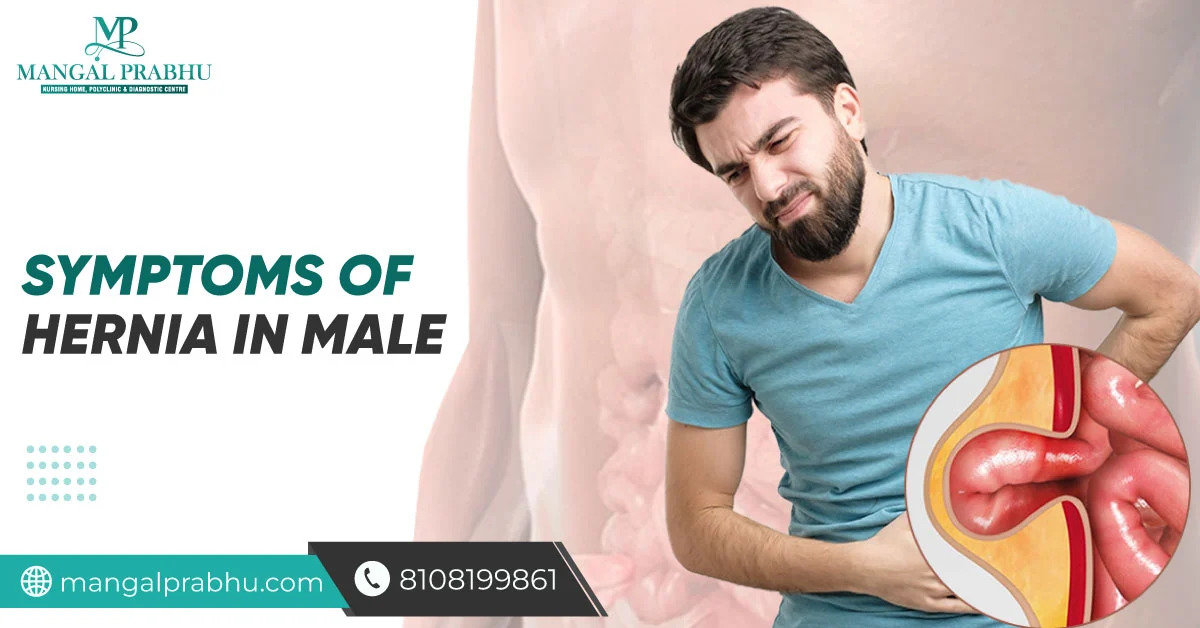
Symptoms Of Hernia In Male
I. Introduction
This condition can develop in various parts of the body, but it commonly occurs in the abdomen or groin area. According to Mangal Prabhu Hospital, recognizing the symptoms of hernia in males is crucial for several reasons. Firstly, timely identification allows for prompt medical intervention, which can prevent complications and alleviate discomfort.
Hernia occurs when an organ or fatty tissue protrudes through a weak spot or tear in the surrounding muscle or connective tissue. Additionally, untreated hernias can lead to more serious complications, making early detection essential for optimal outcomes. Here, you can delve into the various symptoms of hernia in males.
II. Common Symptoms of Hernia in Males
i) Bulge or swelling in the groin or scrotum:
One of the most prominent signs of a hernia in males is a visible bulge or swelling in the groin or scrotum area. This bulge may become more noticeable when standing, coughing, or straining.
ii) Pain or discomfort in the affected area:
Hernias can cause varying degrees of pain or discomfort, ranging from mild to severe. This discomfort may worsen with physical activity or prolonged periods of standing.
iii) Heaviness or pressure sensation:
Some individuals with hernias may experience a sensation of heaviness or pressure in the affected area, particularly during physical exertion or lifting heavy objects.
iv) Difficulty or pain during physical activities:
Engaging in physical activities such as lifting, bending, or exercising may exacerbate hernia symptoms, leading to increased discomfort or pain.
III. Less Common Symptoms of Hernia in Males
While the aforementioned symptoms are more prevalent, hernias can also manifest through less common signs, including:
a) Nausea or vomiting:
In some cases, hernias may cause nausea or vomiting, especially if the protruding organ or tissue becomes obstructed.
b) Changes in bowel movements:
Hernias affecting the abdominal region can sometimes lead to changes in bowel movements, such as constipation or difficulty passing stool.
c) Urinary difficulties:
Inguinal hernias, which occur in the groin area, may cause urinary difficulties such as frequent urination or difficulty emptying the bladder.
IV. When to Seek Medical Attention
If you experience any of the symptoms mentioned above, it’s crucial to consult a healthcare professional like Hernia Surgeon in Navi Mumbai promptly. Delaying medical evaluation and treatment can increase the risk of complications associated with hernias, such as strangulation or obstruction of the protruding tissue.
V. Treatment Options
- Surgical interventions: Repairing weakened muscles or tissues through surgical procedures.
- Non-surgical approaches: Utilizing methods like wearing supportive garments or trusses.
- Lifestyle modifications for prevention: Implementing habits such as proper lifting techniques and maintaining a healthy weight to reduce the risk of hernia development.
VI. Conclusion
Recognizing the symptoms of hernia in males is essential for early diagnosis and prompt intervention. By being aware of the common signs and seeking timely medical attention, individuals can effectively manage hernias and minimize the risk of complications.
If you’re experiencing any symptoms suggestive of a hernia, don’t hesitate to contact Mangal Prabhu Hospital for expert evaluation and hernia treatment in Navi Mumbai. Your health and well-being are our top priorities.

How To Relieve Hernia Pain?
What is a Hernia?
Hernia is a common abdominal issue that can obstruct the overall well-being of an individual. This issue can be caused due to an undesirable strain and weakness in the tissue or muscle. Hernia most commonly happens when fatty tissue in the abdominal area squeezes through a weak spot in a fascia or connective tissue. Hernia issues are harrowing and can get worse with time. Thus, it would be best for an individual to get proper Hernia Treatment in Navi Mumbai to live a healthy and peaceful life. Furthermore, Mangal Prabhu Hospital has world-class doctors who specialize in offering the best treatment plan for Hernia for the betterment of their patients.
Types of Hernia
- Inguinal Hernia: This Hernia most commonly occurs in men’s groin area. Inguinal Hernia contains the protrusion of a part of the intestine via a weak spot in the abdominal tissue.
- Femoral Hernia: Similar to inguinal hernias but occurs lower in the groin, near the upper thigh. It is more common in women.
- Umbilical Hernia: Develops near the navel or belly button and is often seen in infants. It occurs when the abdominal muscles do not close properly after birth.
- Incisional Hernia: Forms at the site of a previous abdominal surgery, where the abdominal muscles have weakened or separated.
Symptoms of Hernia
Hernias often present with the following symptoms:
- Visible Lump or Bulge
- Pain or Discomfort
- Aching or Burning Sensation
- Indigestion or Difficulty Swallowing
Also Read: CAN HERNIA BE TREATED WITHOUT SURGERY?
Causes of Hernia
The development of hernias is often attributed to a combination of muscle weakness and increased pressure on the affected area. Some common causes include:
- Age-Related Muscle Weakness: Muscles naturally weaken over time.
- Persistent Coughing or Sneezing: Increases abdominal pressure.
- Straining During Bowel Movements: Especially in cases of constipation.
- Heavy Lifting: Puts strain on abdominal muscles.
How to Relieve Hernia Pain
Surgery is one of the most effective treatments for Hernia. Thus, consulting with the best Hernia Surgeon in Navi Mumbai from Mangal Prabhu would be best. However, some of the common ways to relieve hernia pain are:
- Medication: It is best to ask your healthcare provider to suggest an over-the-counter painkiller for hernia pain.
- Wearing a Truss or Support Belt: Provides support to the affected area.
- Cold or Warm Compress: Applying to the Hernia may alleviate pain and reduce swelling.
- Avoiding Heavy Lifting: Minimize activities that strain the affected area.
- Maintaining a Healthy Weight: Excess weight can worsen hernia symptoms.
- Dietary Changes: For hiatal hernias, smaller, more frequent meals and avoiding certain foods.
Prevention Tips
Taking proactive steps to prevent hernias or reduce the risk of recurrence includes:
- Maintaining a Healthy Weight: Through a balanced diet and regular exercise.
- Avoiding Straining During Bowel Movements: Ensuring an adequate fiber intake and staying hydrated.
- Lifting Properly: Using proper techniques, such as bending at the knees and keeping the back straight.
- Quitting Smoking: Smoking weakens tissues, increasing the risk of Hernia.
Conclusion
Hernia is a critical issue that requires proper medical attention and treatment. However, by following the preventive measures and taking the precautions mentioned, an individual can quickly get through hernia pain without hassle.

What is Hernia in Women?
What is Hernia and How Does It Affect Women?
A hernia is a disorder that develops when an organ or piece of tissue pushes through a tear or weak area in the surrounding muscle or tissue. This may occur in the abdomen, groin, or diaphragm, among other body regions. Hernias can appear unexpectedly or develop gradually over time.
According to Hernia Treatment Hospital in Navi Mumbai, women can get hernias, however, they do so less commonly than men do. The following are some typical hernias that might affect women:
Common Types of Hernia in Women
- Inguinal Hernias: More frequently seen in men, these hernias develop in the groin region. Yet women can also get inguinal hernias, especially if they have a history of hard lifting or many pregnancies.
- Umbilical Hernias: These hernias are more frequent in women than in males, particularly in those who have had several pregnancies or who are obese. They develop close to the belly button.
- Incisional Hernias: Hernias at the site of previous abdominal surgery, known as “incisional hernias,” might weaken the abdominal wall and increase the risk of hernias.
- Hiatal Hernias: When a portion of the stomach pushes through the diaphragm and into the chest cavity, a hernia occurs. As they age, women are more likely to develop hiatal hernias, which can be accompanied by reflux symptoms.
Also Read: DO I NEED SURGERY FOR HERNIA?
What are the Causes of Hernia in Women?
Hernias happen when a weak area in the surrounding muscle or tissue allows an internal organ or tissue to protrude through. Although hernias are typically associated with men, they can also affect women. Although the causes of hernias in women might vary, the following characteristics are frequently linked to an increased chance of getting one:
1. Childbirth During Pregnancy:
The stress on the abdominal muscles during these processes might weaken the abdominal wall, increasing the risk of a hernia.
2. Obesity:
Having a large waistline or being obese can place additional tension on the abdominal muscles and increase the risk of a hernia.
3. Heavy Lifting:
Frequently lifting weights or objects that are heavy might cause the abdominal muscles to get strained and cause a hernia.
4. Coughing or Sneezing Repeatedly:
Prolonged coughing or sneezing can impose stress on the abdominal muscles, causing them to deteriorate over time.
5. Past Operations:
According to a General Surgeon in Navi Mumbai, women who have had abdominal surgery in the past may be more susceptible to hernias.
6. Genetics:
Due to a family history of the illness, certain women may be predisposed genetically to have hernias.
What is Abdominal Wall Weakness in Women?
Despite being similarly linked, abdominal wall weakness in women is not the same as a hernia. When the muscles and tissues that make up the abdominal wall are weak or injured, it is easier for organs and other tissues to push through the weak spot and produce a hernia.
This condition is referred to as abdominal wall weakness. Although poor abdominal wall tissue can result in the development of a hernia, this is not always the case. But, if unchecked, abdominal wall weakness can eventually raise the chance of developing a hernia. Both disorders can cause pain, discomfort, or an abdominal bulge as symptoms.
What is Diastasis Recti?
The two parts of the rectus abdominis muscle, also referred to as the “six-pack” muscle, split along the Linea alba, the connective tissue that runs along the middle of the abdomen, in a condition known as diastasis recti. Pregnancy, excessive weight gain, or abdominal surgery are all risk factors for this separation. Diastasis Recti is not the same as hernia though it is possible to have both a hernia and diastasis recti, and in certain situations, both diseases may need to be treated surgically.
Conclusion
Women can develop hernias just as frequently as males. Femoral hernias, for example, maybe more common in women than in men because of the differences in their anatomical structures. Due to the stress imposed on the abdominal muscles during pregnancy and after childbirth, women may also be more susceptible to developing hernias.
Women should be aware of the symptoms and signs of a hernia, which include pain, discomfort, and an obvious bulge in the affected area. Early medical intervention can stop the hernia from getting worse and potentially leading to catastrophic problems.
Women’s hernias can be treated surgically or with supporting clothing or belts that can help control discomfort. In general, women can lower their risk of getting hernias and maintain their health and well-being by being aware of the risk factors and taking preventative actions.
